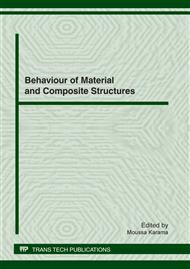p.89
p.102
p.115
p.126
p.139
p.151
p.161
p.173
p.187
Delamination-Crater Interaction in Damage of Glass/Epoxy Composite Plates Subjected to Impact Fatigue
Abstract:
The use of composite materials is increasing although their behavior under impact fatigue loading remains rather unknown. This study is to assess the evolution of damage, especially delamination and crater, in a composite Glass/Epoxy woven fabric, using repeated impact tests at low energy levels (<10J). Both types of damage that arise and grow within the material cannot be independent from each other. Our objective in this work is to establish the interaction between two damages (delamination and crater) on laminate damage, and understand the contribution of each of them in the different phases through which passes the composite before perforation. To do this, impact fatigue tests are carried out on composite plates and measures of the crater size (diameter and depth) and the size of the delaminated area (diagonals from a diamond shape) are collected for different numbers of impacts and impact energies. A question worth asking; can we foster one of these damages over the other especially when we are interesting to the “structure applications”, where one "prefers" perforation to delamination (while completing correctly the function's intended to the structure), or “shielding applications”, where one "prefers" the delamination to perforation. Although the range of impact velocities is not the same, it is still interesting to consider the synergy between these two damages at low impact velocities, always in the case of “structure applications” and “shielding applications”.
Info:
Periodical:
Pages:
139-150
Citation:
Online since:
January 2012
Authors:
Price:
Сopyright:
© 2012 Trans Tech Publications Ltd. All Rights Reserved
Share:
Citation:


